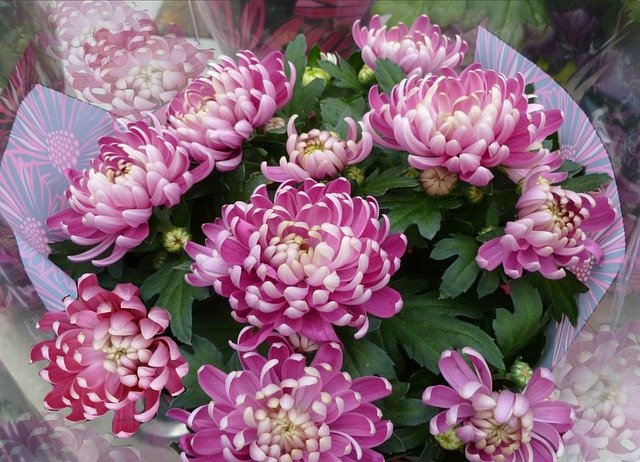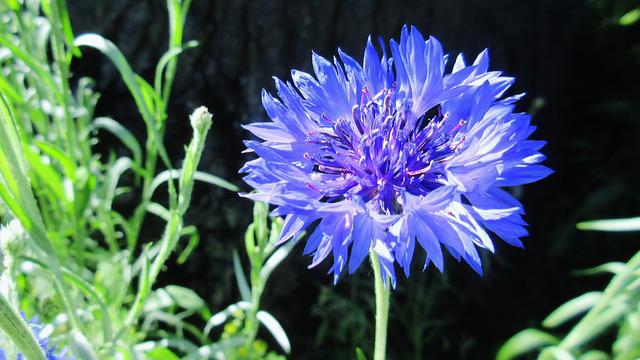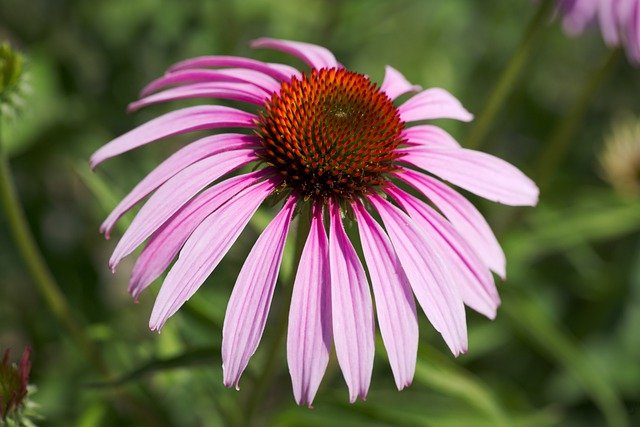Flowers That Look Like Chrysanthemums

Are you looking for a unique flower to add to your garden? Check out these flowers that look like chrysanthemums! With their vibrant colors and unusual shapes, these flowers will add a splash of personality to your garden. Whether you’re looking for a bright accent or an all-encompassing flower, this chrysanthemums-like are sure to please. Check them out!
Table of Contents
African Daisy
Osteospermum spp.
Similar to typical daisies, African daisies have petals that radiate out from a central disk. They belong to the same family as zinnias and shasta daisies, the Asteraceae. However, their vibrant color is nothing like the traditional daisy. Some consumers believed African daisies must have been colored when they were initially introduced on the market. Even the flower’s center disks can have the appearance of being painted with metallic paint. Petals can either radiate out in a tubular spoon shape or be smooth and flat like those on a regular daisy.
Aster
Aster spp.
Asters, like garden mums, flower in response to the shorter days of autumn, providing gardeners with a magnificent display of buds that can bloom from August to October. New World asters are native to North America. They include several species in several distinct plant genera and hundreds of cultivars. Still, for gardeners, asters are just great flowers that offer purple or blue daisy-like blossoms late in the season. A capitulum is the blossom of an aster. It is a cluster of blooms that appears to be a single flower from a distance. The capitulum’s bright yellow center attracts pollinators. The petals of the aster flower are typically long and thin, suggesting sun rays. The outline of an aster bloom resembles a dazzling, multipoint star. Asters have one or more layers of petals.
China Aster
Callistephus chinensis
Various cultivars come with a vivid yellow center disc in various colors, including white, blue, yellow, red, purple, and pink. From early July to late summer, the China aster produces magnificent, 3-5-inch diameter blooms. They have rows of petals that are single, full-double, or semi-double. There are numerous cultivars available that are 8 to 36 inches tall and have a variety of flower types, including single daisy-like flower heads with yellow centers and double flower heads with shaggy or pompom forms. Unlike the clustered flowers of native aster species, each flower on this plant develops on a separate stalk. This plant originates in the temperate regions of China and Korea and has experienced a great deal of horticultural modification to produce the wide variety of cultivars it does today.
Bachelor’s Button
Centaurea cyanus

Given that this native European plant easily naturalizes in most regions of the United States, it offers a variety of purposes in the landscape. In addition to the classic bachelor button flower hue of blue, attractive blossoms are now offered in red, white, and pink tones. On July 4th, combine red, white, and blue flowers to create a patriotic display. Plant bachelor button flowers where they can spread and become natural, such as in borders, rock gardens, and sunny locations.
Black-Eyed Susan
Rudbeckia hirta
The dependable black-eyed Susan has established itself as a garden mainstay. Broad, rough-textured, ovate-shaped, green leaves are covered in daisy-like rays with bright yellow petals and dark center disks. The Midwest is home to this wildflower’s natural habitat, where it can be seen flourishing in parks and by the sides of roadways. Its capacity to self-seed for gardens with lots of wildflowers makes it a fantastic option. After the final spring frost, you can plant it. Despite taking up to three years to reach its maximum height, it will bloom in its first summer.
Blanket Flower
Gaillardia spp.
All Gaillardia species have flowers with a large number of tiny central disc flowers surrounded by 15 or more sterile ray flowers, while some species don’t have ray flowers. The ray flowers typically have long, three-toothed, flat petals, but they can be rolled up like trumpets in rare species. The heat-tolerant, heavy-blooming blanket flower is a nice addition to the informal garden because of its brilliantly colored daisy-like blossoms in red, orange, and yellow hues. There are roughly 25–30 species in total.
Ice Plant
Delosperma spp.
Ice plants can be used as ground cover or edging plants in rock gardens, slopes, or in sunny but protected desert gardens. Although they occasionally can extend much more, individual plants typically have a spread of 2 feet or less. They also function well as plants in containers, easily filling the top and eventually spilling over the sides. Make sure the area you wish to plant has plenty of sunlight and quick-draining soil. Plants should be placed 15 to 18 inches apart since they will soon spread to cover the void. Remove any stems that were winter-killed each spring.
Chamomile
Matricaria chamomilla
The delicate, daisy-like flowers bloom from May to September and feature a tiny yellow solid cone encircled by white rays. The leaves have a fluffy look and are doubly split. They have some shine and are a bright green color.
Daisy
Bellis perennis

Perennial herbaceous can reach a height of 20 centimeters (8 inches). Its flat-growing leaves range in length from 2 to 5 cm (34 to 2 in) and have rounded or spoon-shaped tips. It also has short-spreading rhizomes. Lawn daisies get their name because they frequently colonize lawns and are challenging to remove by mowing. From March to September, it blooms, and during that time, it displays the heliotropism phenomenon, in which the flowers move with the sun’s location in the sky.
Zinnia
Zinnia elegans
The Asteraceae family, popularly known as the daisy family, includes zinnia. It is a bushy plant or subshrub that can withstand low temperatures but not frost. Each kind of leaf has a marginally unique form. Depending on the species, they might have sharp points like arrows, lance-shaped or thin shapes, or be rough or soft. The colors and shapes of the blooms also vary greatly. While certain flowers, like zinnias, resemble dahlias, others, like cacti, remind us of daisies. Among the color options are white, yellow, orange, red, rose, pink, purple, lilac, and multicolored blossoms.
Dahlia
Dahlia pinnata
Gorgeous dahlias bloom from the middle of summer till the end of the season. The majority of cultivars grow to a height of 4 to 5 feet. They bloom in a spectrum of colors and sizes, ranging from tiny 2-inch pompoms to enormous 15-inch “dinner plates.”
See our guide for details on growing and caring for these breathtakingly beautiful, vibrant flowers, which bloom from the middle of summer until the end of the season, when many other plants are beyond their prime.
Calendula
Calendula officinalis
For its daisy- or chrysanthemum-like bright yellow to deep orange flowers, which in mild areas show over a lengthy summer to fall bloom, it is a popular annual grown in beds and borders. Thanks to cultivars, many pastel colors and certain bicolors are now included in the range of flower colors. Three to four-inch diameter single or multiple flowerheads may have to contrast darker center disks. Shakespeare’s time in England saw a lot of use for the species, an Old World herb, and garden plant. It usually gets up to two feet tall and two feet wide. Despite having a mildly bitter flavor, the blossoms and leaves are edible and can be added fresh or dried for color and flavor to soups, salads, or rice dishes. Lance-shaped to oblong-obovate, aromatic, green leaves that can grow up to 6″ long.
Marigold
Calendula officinalis
Beautiful yellow, orange, or red composite blooms that are either solitary or in clusters are produced by members of the genus Tagetes. On the stem, the leaves are placed in opposition to one another and are often neatly cut. Each flower head is supported by distinctive bracts, which resemble leaves.
Gerbera
Gerbera jamesonii
The African Daisy is another name for the gerbera flower. A huge capitulum with eye-catching, two-lipped ray florets in yellow, orange, white, pink, or red is produced by gerbera species. Although the capitulum appears to be a single flower, it comprises hundreds of smaller blossoms. Depending on where they are located within the capitulum, the shape of the blooms changes. The diameter of the flower heads can range from 7 cm to 12 cm. Gerberas are particularly well-liked and frequently used as cut flowers or ornamental garden plants. Most domesticated cultivars are a result of a hybrid between Gerbera jamesonii and Gerbera viridifolia, another South African species. The hybrid variety is referred to as Gerbera. There are countless varieties. Their size and shape range widely. Among the colors are white, yellow, orange, red, and pink. Sometimes a flower’s center is black. The petals of the same flower can frequently be found in various colors.
Purple Coneflower
Echinacea purpurea

Purple coneflowers, native to the eastern United States, are common in flower gardens. By including purple coneflower in the yard or flower bed, you can attract bees and butterflies, which will help pollinate the neighboring plants. The plant also offers a tall background or repetitive rows of enormous, daisy-like, purple flowers that are frequently 6 inches (15 cm) across. The strong stalks, which can grow to a height of 5 feet (1.5 meters), rarely bend or need to be staked to maintain an upright appearance.
False Sunflower
Heliopsis helianthoides
False sunflowers, also referred to as oxeye sunflowers, are low-maintenance perennial herbaceous plants that naturally thrive in meadows. Everywhere else in North America, except the western third of the continent, they are native wildflowers. They grow quite quickly in the garden but are best started in the spring or fall. They probably won’t blossom in their first year. False sunflowers have branches that branch and triangular-shaped leaves, which enable the plants to develop busily. Yellow-orange, double or single daisy-like flowers are arranged around a golden-brown core disk.
